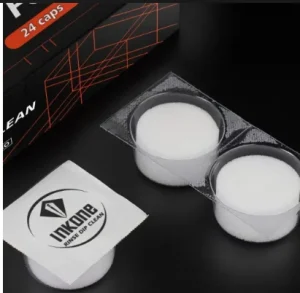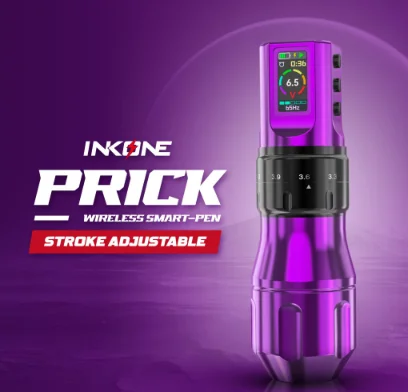
Every tattoo artist knows the drill. You’re halfway through an outline, ready to change from black to blue, and the only thing between you and the next step is that cloudy cup of rinse water. You dip the needle once, twice, maybe three times. The water splashes a bit. The ink lightens but never quite clears away. You tap the side of the cup, give the machine a little shake, and hope it’s clean enough.
It’s worked for years, sure. But let’s be honest—it’s messy, slow, and sometimes unreliable. This is where the tattoo cleaning sponge comes in. A small piece of foam may not look like much, but for many artists it’s becoming the smarter, faster, and safer way to clean needles during tattooing. Let’s walk through why sponges are replacing the old rinse cups and how they change the day-to-day routine in studios.
Why Needle Cleaning Matters in Tattooing
Cleaning needles isn’t just about neatness. It’s about hygiene, ink quality, and speed.
Hygiene and Safety
Cross-contamination is the biggest fear for both artists and clients. Old rinse cups full of murky water don’t always clean as well as they should. If pigments stick around or dirty water is reused too long, it increases risk.
Ink Quality and Color Accuracy
Switching from red to yellow should be crisp and clean. But if there’s leftover pigment on the needle, the new color becomes muddy. Blends take longer, and colors don’t pop as much.
Time Inside the Studio
Every dip into a rinse cup takes time. It may feel small, but over a long session those minutes add up. Imagine working on a full back piece with ten different colors. That’s a lot of rinsing.
The Old-School Method – Rinse Cups
For decades, the rinse cup was the only way to clean. You filled a small cup with water, dipped the needle, swirled it around, and hoped for the best.
How Rinse Cups Work
- Dip the needle into water.
- Let the pigment swirl out.
- Repeat until the needle looks clean.
Limitations of Rinse Cups
- Water becomes dirty within minutes.
- Leftover pigment sticks around.
- Splashes can stain the station.
- Frequent refills waste time.
Plenty of artists remember the frustration. You rinse, but the needle isn’t fully clear. That little leftover bit shows up in the next line or shade.
What Is a Tattoo Cleaning Sponge?
A tattoo cleaning sponge is a disposable foam insert placed inside a small cap or cup. Instead of swirling the machine in water, the artist wipes or dips the needle directly into the sponge.
Materials
- Eco-friendly foam that’s hypoallergenic
- Sterilized before packing
- Gentle but durable enough for sessions
Design Purpose
- Cleans needles quickly without splash
- Absorbs leftover ink
- Works for blending, drying, or diluting pigment
It sounds simple, but sometimes simple tools make the biggest difference.
Step-by-Step: How to Use Tattoo Cleaning Sponges
Switching from rinse cups to sponges isn’t complicated. The process is straightforward:
Place two small cleaning cups on your station—one filled with water, one with the sponge.
Rinse the tattoo needle briefly in clean water.
Dampen the sponge slightly with sterile water.
Dip or wipe the needle against the sponge.
The sponge absorbs extra ink, leaving the needle clean for the next color.
That’s it. No swirling for a full minute. No dirty water spilling onto the table. Just a quick wipe and move on.
Why Sponges Outperform Rinse Cups
Tattoo Cleaning Sponges are more than just “new supplies.” They directly solve the old problems artists faced with rinse cups.
Cleaner Needles
Instead of mixing in cloudy water, pigment gets absorbed into the sponge. That means less residue and fewer clumps.
Faster Color Changes
Switching from black to gray or blue to green takes seconds. This keeps the flow of the session smooth and less frustrating for both artist and client.
Less Mess
No more water splashes, tipped cups, or stained tables. Sponges stay neat and easy to handle.
Safer Practices
Disposable and sterilized, they lower the risk of contamination. You start with a clean sponge each time—no second-guessing.

Benefits for Professional Studios
The small details make a big difference in how a studio feels and runs.
- Save time:Fewer minutes lost between color changes.
- Cleaner space:Clients notice neat workstations.
- Professional touch:Disposable tools look modern and trustworthy.
- Smoother workflow:Artists focus on tattooing instead of rinsing.
Think of it this way: if you save even 20 seconds every time you clean your needle, by the end of a long session you’ve saved half an hour. That half hour can mean finishing earlier, taking another client, or simply feeling less drained.
Sponges vs. Rinse Cups: A Direct Comparison
| Feature | Rinse Cups | Tattoo Cleaning Sponges |
| Hygiene | Water gets dirty fast | Sterilized, single-use foam |
| Speed | Repeated rinsing, slower process | Quick wipe, clean in seconds |
| Ink Blending | Residue often remains | Smooth transitions, no leftovers |
| Workstation Clean | Risk of spills and stains | Compact and tidy |
| Professional Look | Old-fashioned, less polished | Modern and hygienic |
Why INKONE Disposable Sponge Stands Out
Among the many tattoo supplies out there, INKONE provides disposable sponges designed with working artists in mind. Each box includes 24 pieces, giving studios enough stock to cover busy weeks. The foam is eco-friendly, hypoallergenic, and sterilized, making it safe for professional use. These sponges aren’t just for cleaning—they’re also handy for drying, blending, and even diluting ink when needed. For artists, that means fewer tools cluttering the table and more focus on the work at hand.
Based in China, Yiwu Yinke Electric Tools Co., Ltd. has years of experience building tattoo equipment and accessories. Their product line covers everything from wireless machines to transfer paper to disposable supplies. What makes them different is their focus on real studio needs. They design items that are tough, practical, and tested by professionals who tattoo for hours every day. That’s why many artists trust their tools—they fit naturally into the workflow.
Conclusion
The tattoo cleaning sponge is not just another item on the supply list. It fixes everyday problems: messy rinse cups, leftover pigment, wasted time, and risk of contamination. For clients, that means a safer and cleaner tattooing experience. For artists, it means smoother sessions, sharper colors, and less hassle.
Switching to sponges may seem like a small step, but the payoff is real. And with professional-grade products from INKONE, studios can keep things clean, efficient, and reliable without complicating their routine.
FAQs
Q1: How long can I use a tattoo cleaning sponge during a session?
It’s best to use one sponge per client. Since they’re disposable and sterile, you always start fresh.
Q2: Are tattoo cleaning sponges safe for sensitive clients?
Yes. They’re made from sterilized, hypoallergenic foam, so they’re gentle and safe.
Q3: Do tattoo cleaning sponges completely replace rinse cups?
For most artists, yes. Some still keep a water cup nearby, but sponges handle the majority of cleaning tasks.
Q4: How do sponges help with color blending?
By wiping off leftover pigment quickly, sponges keep shades clean and transitions smooth.
Q5: Why should studios choose disposable sponges over reusable tools?
Disposable sponges save cleaning time, reduce contamination risks, and keep the station more professional-looking.






